Chellington Church Repairs and Alterations
![Chellington church from the south-west about 1815 [X707/1]](/CommunityHistories/Chellington/ChellingtonImages/Chellington-church-watercolour-picture.jpg)
Chellington church from the south-west about 1815 [X707/1]
Most of the structural history of the church can be found in detail in Bedfordshire Historical Record Society Volume number 73 of 1994 Bedfordshire Churches in the Nineteenth Century: Part 1 Parishes A to G, put together by former County Archivist Chris Pickford from numerous sources some held by Bedfordshire Archives and Records Service and some held elsewhere or published.
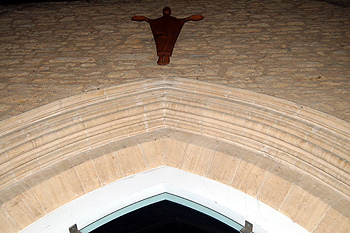
The chancel arch August 2012
In 1578 the churchwardens reported that the chancel was in s state of decay “at the parson’s defalte, but the parson hathe begone to mende hit. Our churche wyndowes want glasinge” [ABC3]. The parson was Thomas Wells.
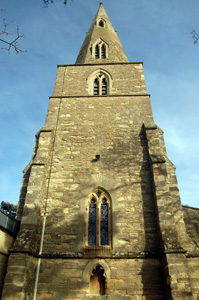
Chellington church tower from the west March 2009
There is a large gap in our knowledge of the history of the building until 1824 when the spire was repaired at a cost of £31 [P145/5/1]. More repairs were undertaken in 1841, costing £25. The parishes of Carlton and Chellington were united in 1769. Between 1833 and 1844 the idea of building an entirely new church to serve the two parishes was actively considered. Thankfully the vestry for Chellington, on considering what to do with its church in April 1843 [P145/5/1], decided to repair it rather than replace it. Chief amongst repairs were more to the spire.
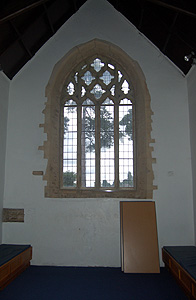
The chancel east window August 2012
WA was a pseudonym employed by John Martin of Eversholt. In the years eiher side of 1850 he visited the great majority of churches in the county in order to condemn their upkeep in the pages if the Northampton Mercury. His pieces are usually both pompous and scathing which makes them entertaining reading. His account of Chellington was published on 17 July 1847: “The chancel roof is ceiled; all beneath is whitewashed; a little drab is introduced, which in some degree mitigates the glare of the white-plashing. The roof has been so much lowered as to interfere with the window, which contains some remains of painted glass. The communion table is very common; not far from it is a tall cupboard, very much resembling a sentry-box; its use was not mentioned. We are glad, however, to state that no seats have been permitted to intrude their ugliness in this part of the church. The pavement is in very good order”.

The nave roof August 2012
“The nave has a timber roof. The pulpit and reading-desk are very common, forming a sad contrast to the ancient oak sittings underneath, which are all open. The pews are happily banished to the aisles; this is infinitely preferable to placing them, as is too frequently the case, in the best part of the church. The chancel screen is gone, and its place is supplied by a miserable railing. The western window is hid from view. The font has its lead lining; it contained ropes and a common pudding basin. “Fonts” says Markland ”will be found in a state of filth and decay disgraceful to us as members of Christ’s church, professing to hold in reverence the sacraments which He has ordained, but wholly regardless of the places set apart for their celebration. On this point, we should cry out loud and spare not””.
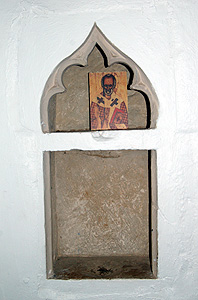
The piscina in the south wall of the chancel August 2012
"A corner in the south aisle, which had very much the appearance of an ancient altar tomb, is converted into a receptacle for decaying vegetable matter and other rubbish; it is true that this dirty trick is partly concealed by a wooden door. The roof of the chancel is tiled, but lead is preserved on the aisles. The churchyard is not locked up, and cattle are not allowed to graze it. The porch is partly paved, we grieve to record it, with monumental slabs, which from inscriptions as yet remain, must once have stood in the churchyard. We are sorry that this church does not stand alone in this disgraceful desecration; in one we have seen, portions have been used to form a gutter to receive rain water from the roof. What the duties of Archdeacons are, I profess not to know; but surely to remonstrate against such churchwarden abuses, should form one of them. Service is performed only once a day: we know not if there is a dissenting chapel within the village, but if there is, we will answer for it, that it is open twice on Sunday. There is no school”.
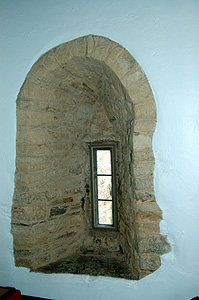
Window in the north wall of the chancel August 2012
In the late 1840s some ancient glass fragments were put in the east window [P145/5/1] as noted by John Martin. In 1850 repairs were made to the roof of the nave and pews in the north and south aisles [P145/5/1].
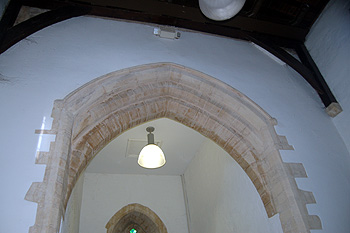
The west tower arch August 2012
Major repairs were undertaken in 1869; the work was paid for by Lord Dynevor, the Ladies of the Manor and the parishioners. John Martin’s hated plaster was removed from pillars and arches, stonework re-pointed, the roof repaired, the floor laid with red and black tiles, open seating introduced and the west arch opened into the tower. The rector paid for repairs to the chancel and its roof at the same time [P145/5/1].
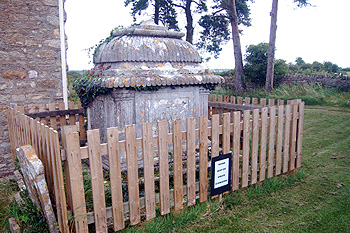
The tomb of Sir Robert Darling August 2012
More work was necessary in the 1890s. the steeple, south aisle, nave and chancel were all restored in 1893. In that year and in 1904 cracks caused by the settlement of the east end of the north aisle were also repaired [ABV3]. The water table lying close to the surface caused bones to be brought to the surface of the graveyard well into the 1980s as the writer (in this his last piece for the Community Archive pages he began in 2007) recalls.
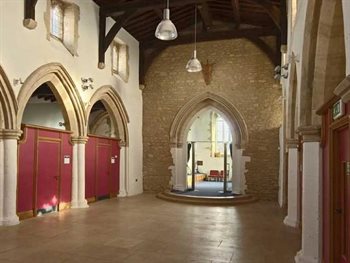
The interior looking east courtesy of The Chellington Centre
Saint Nicholas was declared redundant in 1972. From 1978 the church was used as a youth centre by the Diocese of Saint Albans until 1991. By the middle of the 1990s much work needed to be done to bring the building up to standard. By 2004, when work commenced, £1,200,000 had been raised and the Chellington Centre was formed to provide a residential youth centre. The first youth group to use the newly refurbished building was in September 2005.

The church and the annexe from the south March 2009
The splendid meeting room built against the north wall of the tower, with its wonderful views over the Great Ouse valley was built in 2005. The architect was Bruce Deacon.

The west window August 2012